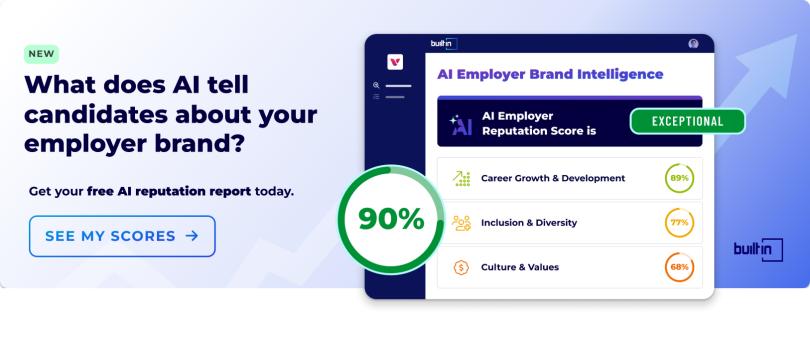Most recruiters dream of building a talent pipeline chocked full of candidates, but it can take years of hard work and a healthy amount of trial and error to pull off such a feat.
We’ve compiled a list of 80+ tips, tools and resources to help you sidestep some of that work (and a lot of that trial and error). This article will help you plan, implement and manage a talent pipeline strategy, regardless of your level of experience. Some of the information applies specifically to the world of technical recruiting, but there’s something for recruiters in every industry.
See how your employer brand is performing in AI tools like ChatGPT and Google.
Before You Build Your Talent Pipeline Strategy

Define your needs - An effective talent pipeline should address short and long-term organizational talent needs. Before sourcing any candidates, sit down with all stakeholders to define and prioritize your requirements.
Do your research upfront - Your talent pipeline is only valuable if it’s full of qualified potential candidates. Do some in-depth research upfront to identify exactly what you need in a new hire and limit your search to individuals that meet these requirements.
- Candidate Research — The Critical Information That You Must Know About Your Recruiting Targets
- The Most Damaging Strategic Omission in Recruiting — Candidate Research
Create meaningful candidate personas - Candidate personas — semi-fictional representations of your ideal candidate — can help you better understand the individuals you’re looking for.
Combined with the research you’ve (hopefully) already conducted, these resources will get you started.
Develop your Employee Value Proposition - An Employee Value Proposition (EVP) is the “people deal” that defines why an individual would want to work for your company, and what the organization expects in return. While the EVP is more associated with employer branding than pipelining or sourcing, a strong EVP will arm you with a sales pitch when contacting passive candidates, so it’s well worth taking the time to create.
Know your talent pipeline metrics - There was a time when recruiters worked in the dark, with little access to the data and analytics needed to quantify their efforts. Thankfully those days are long gone. There are a host of metrics you can use to gauge the efficacy of your pipelining, so determine what’s most relevant to your efforts and get busy measuring.
- 3 Sourcing Metrics to Optimize Your Sourcing Strategy and Process
- Sourcing Metrics: 5 Essential KPIs to Track
- Sourcing Metrics: 3 KPIs to Track

Start Building Your Pipeline From Within

Embrace a collaborative approach - Need some help finding candidates for your pipeline? Why not ask for it? A collaborative-hiring strategy involves a broader team of contributors (employees, hiring managers, other recruiters, etc.), expanding your resources and network and increasing the odds you’ll find qualified candidates for your talent pipeline.
- Get Out of Your Cubicle and Into a Collaborative Recruiting Process
- Collaborative Hiring — The Top 10 Reasons Why You Should Switch to It
- Collaboration in the Hiring Process
Mine your ATS for hidden gems - If you use an Applicant Tracking System (ATS) in your recruitment efforts, you already have a talent pipeline at your fingertips. Mining your ATS for candidates can be the easiest and most economical way to find talent. Just because a candidate wasn’t right for one position doesn’t mean they won’t be the perfect fit for another.
Groom existing talent - External hires make 18-20% more than internal employees doing the same job, but their performance consistently ranks lower, according to a Wharton study. When building your pipeline, watch for internal employees who may be ready to assume a greater role.
- Who to Promote? 10 Keys to Identifying People With High Potential
- 15 Signs Your Employee Is Ready to Become a Manager
- Who Should Get Promoted? 4 Signs of a Promotion-Ready Employee
Launch An Employee Referral Program

Ask the right questions - “Do you know anyone who would be a good fit for this role?” As a recruiter, you probably ask this dozens of times a week, but have you ever considered just how big a question it is? Many employees won’t be able to answer simply because they can’t wrap their head around what a good candidate looks like. Rather than ask big, hard-to-answer questions, consider posing smaller, more digestible queries. Google switched to this approach, and it’s paying dividends.
Incentivize referrals - An incentive program can provide that extra bit of motivation your employees need to start reaching out to their personal networks, and there’s no need to fret if a cash payout isn’t a viable option. There are plenty of non-financial incentives that work wonders.
Don’t delay the payout - If you do create an employee referral incentive program — cash-based or otherwise — delaying the payout is one of the worst mistakes you can make. If employees know the fruits of their labor won’t be realized for months, they’re less likely to participate.
Promote, promote, promote - If you want your employees to participate in a referral program, you have to make sure they know about it. Check out these examples of creative ways to promote your employee referral program internally.
Additional employee referral program resources - When it comes to employee referral programs, there’s plenty to learn. Add these resources to your reading list.
- Employee Referral Program Best Practices
- Enhance Your Employee Referral Program Marketing Approach
- When It Comes to Referral Bonuses, This Company Proves That Experiences > Cash
- The Complete List of Employee Referral Program Best Practices (Part 1 of 2)
- The Complete List of Employee Referral Program Best Practices (Part 2 of 2)
- Employee Referral Program Tips That Actually Work!
Get Involved With Recruitment and Industry Events

Host your own events - Hosting your own recruiting event guarantees your firm will be the star of the show, but it also means success or failure is up to you. Planning ahead will help you account for unexpected variables, but you may want to consider partnering with an event planner if this isn’t an area of expertise.
- 3 Steps to Planning a Kick-Ass Recruiting Event
- How to Stop Sabotaging Your Recruiting Events
- How to Plan a Successful Recruitment Event
Participate in third-party events - Third-party recruiting events typically feature multiple companies, so you won’t be the only game in town, but these events are planned and executed by the host, which will let you focus on your pitch. More companies will also draw more attendees, exposing your company to a larger pool of talent.
- Preparation Checklist for Job Fairs and Recruitment and Hiring Events
- Career Fair Tips for Employers
Participate in college recruiting events - Sourcing from college recruiting events can be particularly useful for organizations that aren’t hiring just yet but are planning to fill open positions in the near future. It’s a good opportunity to get your company on students’ radar and add qualified entry-level candidates to your talent pipeline.
University Recruiting Essentials: How to Make Your Brand Memorable with On-Campus Events from AfterCollege
- Get Strategic About Campus Recruiting
- University Recruiters: Get Ready for Fall With These Tips for On-Campus Events
- 3 Ways to Get Students Pumped About Your Info Sessions
Don’t forget about conferences and industry events - Tradeshows and conferences are an untapped resource when it comes to recruitment, but you’ll want to be subtle as many events have policies against this practice.
- How to Recruit Talent at a Conference
- Recruiting at Professional Events Is a Powerful but Underused Tool
- 5 Tips for Recruiting at Conferences
- How-To: Identify Passive Candidates on Meetup.com
Master Cold Outreach Emails

A compelling subject line is a must - Even the best cold outreach email will go unread if it doesn’t include a compelling subject line that convinces the recipient to click. Getting over this first barrier can be a challenge, so read up on the fundamentals of writing eye-catching subject lines and apply these tips to your own efforts.
- Recruiting Hack: Crafting the Killer Subject Line for Recruiting Emails
- How-To: Write a Killer Email Subject Line
- Subject Line Tips for Recruiting Emails
Don’t be afraid to use a template - Not a strong writer? No problem. Lean on these templates to get your feet wet and you’ll be crafting Shakespearian emails in no time.
Make it personal - Generic recruiting emails will always fall on deaf ears. Personalizing your message is one of the easiest ways to stand out from the pack and demonstrate you’ve done your homework.
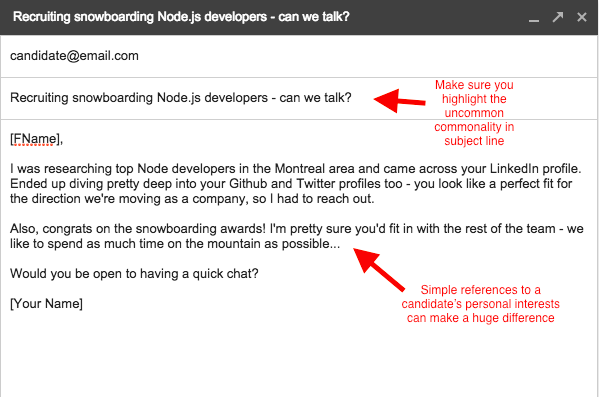
- 5 Ways to Send Super-Personalized Cold Emails
- What I Learned From Reading 8,000 Recruiting Messages
- How to Personalize Emails for Passive Candidates
Additional email outreach resources - Cold outreach emails come with the territory, so make sure to check out these additional resources on the topic.
- Return to Sender: Why Candidates Keep Ignoring Your Recruiting Emails
- 6 Tips for Sending Cold Recruiting Emails That Don’t Get Laughed at
- The Complete Guide to Emailing Passive Candidates
- A Recruiter’s Guide to Email Marketing: Making Passive Candidates Care Enough to Click
- 8 Simple Steps to Improve the Return on Your Passive Candidate Approaches
Learn Effective Search Techniques

Boolean Search - Most recruiters are at least somewhat familiar with Boolean search, but let’s provide a quick review for the unaware. Boolean search allows users to combine keywords and phrases with the words AND, OR, NOT and NEAR (known as Boolean operators) to refine their search.
Boolean search allows recruiters to scour search engines and candidate databases for passive candidates with the skillset they need, but it takes some work to master. Check out these resources to take your Boolean game to the next level.
- Boolean Black Belt
- The Beginner’s Guide to Boolean Search Operators
- A Recruiter’s Guide to Boolean Searching
Semantic Search - Unlike Boolean search, which relies on a string of very specific keywords and operators to deliver meaningful results, semantic search attempts to deliver results based off of contextual meaning. Semantic search can uncover information sourcers would otherwise have missed by not including an exact keyword or phrase.
Semantic Search for Sourcing and Recruiting from Glen Cathey
- The Guide to Semantic Search for Sourcing and Recruiting
- Why Is Semantic Search Important to Sourcers?
Building a Talent Pipeline with Social Media

Understand where your ideal candidates are spending their time - Social media platforms are kind of like ice cream: everyone has their favorite flavor, and most of us are pretty loyal. Before you start sourcing candidates via social media, do a little research to figure out where your target audience spends its time. These resources have the information you need.
Ask your team to get involved - Asking your current employees to share your recruitment content can expand your reach and expose your opportunities to a much larger network.
Create a dedicated careers page - Odds are good your company already has a Facebook page, but convincing your marketing team to utilize it as a pipelining tool may be a challenge. A recruitment-focused Facebook page can be a good way to get around this issue, but be sure to get approval from the necessary parties before pulling the trigger.

If they need some justification as to why this approach makes sense, show them a few of these examples.
Tap into relevant pages and groups - With more than 1 billion users, it’s a virtual guarantee there’s someone on Facebook who would be a great addition to your team. But you can’t count on them finding you. Facebook community pages and groups are a great way to identify and connect with potential candidates, especially hard-to-find technical talent. Check out these resources dedicated to some of the most popular programming languages of 2016:
Understand the psychology behind Facebook - Sourcing through Facebook is a long-term approach because the average user isn’t logging on to find a new job. Taking a little time to understand the psychology behind Facebook users will help you understand how to craft your pipelining strategy for optimal results.
- Top 8 Reasons Why Men and Women Use Facebook
- The Secret Psychology of Facebook: Why We Like, Share, Comment and Keep Coming Back
Use advanced search to drill deep - Twitter’s advanced search feature allows users to get granular by refining their criteria beyond what’s available in a standard search. Recruiters can search by exact keywords and phrases, hashtags, people and accounts to find what they’re looking for quickly and easily. Excluding certain keywords helps filter out irrelevant results, while searching by location can help you find candidates already in your market.
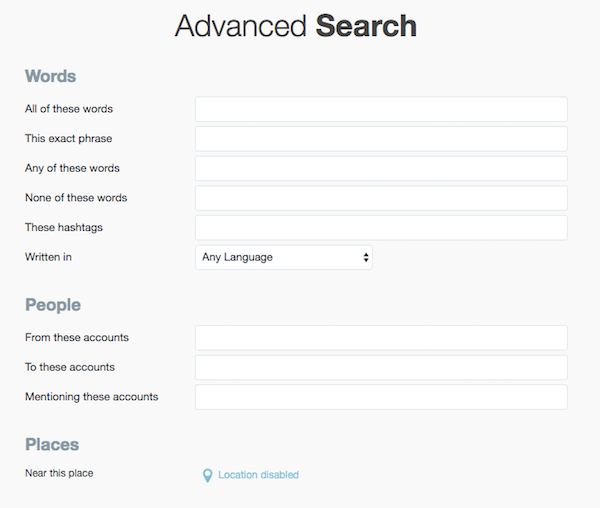
Get serious about hashtag research - A hashtag research tool can supercharge the insight you gain from that funny little # symbol. From basic functions like sorting and organizing to advanced features like real-time analytics, the right tool can take your social recruiting to the next level. Check out some of these popular options.
Github
Master Github’s search syntax - Github is an online network of more than 14 million programmers, which makes it the perfect resource for technical recruiters. The syntax used to search users, however, can be more than a little confusing:
![]()
Check out these resources for some help on searching GitHub and you’ll be filling your pipeline in no time. NOTE: You’ll want to register with GitHub before conducting any searches. Non-members are restricted in what they can search.
- GitHub Search Syntax
- GitHub Search Guidelines
- GitHub User Search Guidelines
- Sourcing Github for Technical Talent
Nurture Your Talent Pipeline

Follow up consistently - “Stay in touch, but don’t be a stalker.” Every recruiter has rolled their eyes at this advice more than once. While well-intentioned, that nugget doesn’t provide much in the way of actionable guidance. This strategic workflow, on the other hand, will help you identify and act on relevant triggers in the candidate nurturing process, so be sure to check it out.
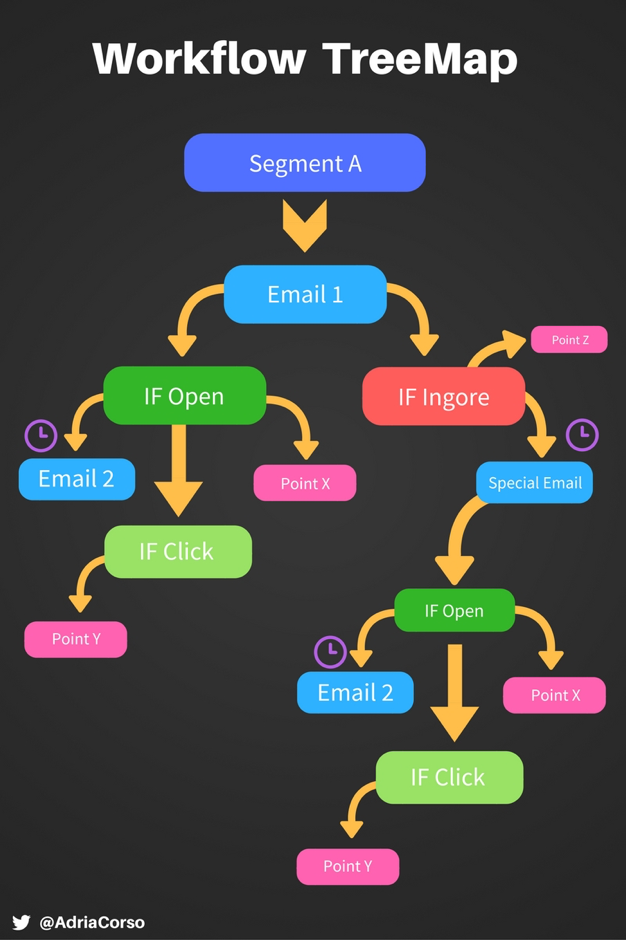
General Tips
Source candidates from job board resume databases - The internet is full of niche job boards that can help you reach candidates in specific industries, and most of these also feature resume databases recruiters can search. We’re partial to our own offerings (duh), but there are a host of options out there.
- BuiltInAustin.com
- BuiltInBoston.com
- BuiltInChicago.com
- BuiltInColorado.com
- BuiltInLA.com
- BuiltInNYC.com
- BuiltInSeattle.com
- 100+ Job Boards For Job Seekers and Recruiters
Pay attention to timelines - There’s a science to the timing of your passive candidate outreach. Entelo analyzed millions of resumes to uncover tenure patterns and found that employees are much more likely to leave at 12-month intervals.
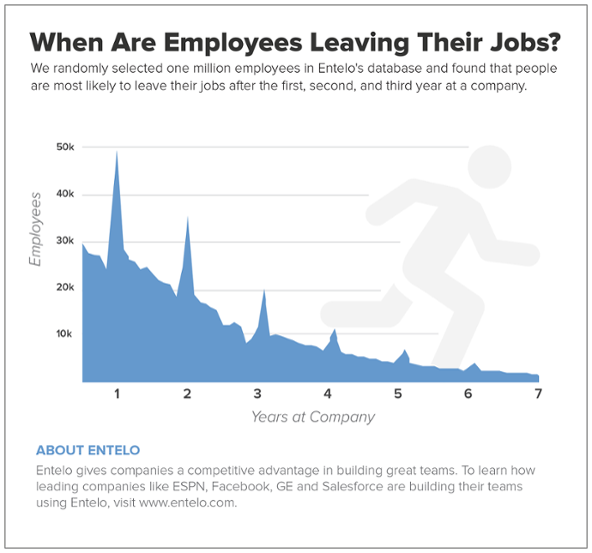
When sourcing candidates, check their social media profiles to see how long they’ve been with their current employer and whether they’re approaching a 12-month milestone. It could dramatically improve your odds of getting a response.

